Google Nexus 4 Review - Google's new Flagship
by Brian Klug on November 13, 2012 8:45 AM EST- Posted in
- Smartphones
- LG
- Android
- Mobile
- APQ8064
- Nexus 4
- Android 4.2
- MDM9215
Battery life in the Nexus 4 is a big concern for many, especially since the Nexus 4 isn’t designed to have a user replaceable battery. What’s inside is a 2100 mAh 3.8V battery which is 8.0 watt-hours. I had been wondering for a while what the chemical compound used in the 3.8V battery cells we’re seeing emerge was, and finally got a tad more info at least about the LG Chem approach. This is the higher voltage chemistry from LG Chem which is Lithium Cobalt Oxide (LiCoO2) based and includes electrolyte additives to prevent gas generation in the cell which affects lifetime during high temperature periods. Although getting the back off of the Nexus 4 is relatively easy and requires just removing two Torx 4 screws and prying up on the plastic, I doubt anyone is going to make a back to accommodate an extended battery due to the presence of 4 antennas which are integrated into the back cover.
The Nexus 4 incorporates wireless charging into that back alongside NFC. For wireless charging the Nexus 4 uses a TI BQ51051b wireless power Li-Ion charger receiver. I’ve been pretty remiss in looking into wireless charging and actually trying it myself, so I went ahead and bought a two-position Energizer Qi compliant charging mat.
The Nexus 4 is Qi 1.1 wireless charging forum compliant, so any charger that is Qi compliant or includes the logo will charge it. Aligning the Nexus 4 on the Energizer mat is a bit tricky since the surface is slick and angled down, and the back of the Nexus 4 is primarily glass, but it isn’t difficult after you know where to align. The Nexus 4 charges from fully discharged to completely charged in 3.033 hours on the Qi mat, which is basically the same charge time as I saw off of microUSB on a BC 1.2 charger.
In Android you’ll see Charging (Wireless) when this mode is employed. I used the Palm Pre touchstone charger a lot back in the day and saw that get pretty hot during a charge cycle. The Nexus 4 doesn’t get nearly as warm. I’ve noticed that at the top of the charge cycle you’ll see the Nexus 4 selectively draw power from the charging dock since there doesn’t seem to be an equivalent trickle charge mode or something, but this is normal.
Battery Life
I’ve had the chance to run more battery life tests on the Nexus 4, and run the cellular test a few more times. The results are quite consistent and we don’t see that result change very much at all. I’ve also added the call time test and tethering results.
We regularly load web pages at a fixed interval until the battery dies (all displays are calibrated to 200 nits as always). The differences between this test and our previous ones boil down to the amount of network activity and CPU load.
On the network side, we’ve done a lot more to prevent aggressive browser caching of our web pages. Some caching is important otherwise you end up with a baseband test, but it’s clear what we had previously wasn’t working. I’ve made sure that despite the increased network load, the baseband still has the opportunity to enter its idle state during the course of the benchmark, we’re not destroying the RRC states with too aggressive of a load time.
We also increased CPU workload along two vectors: we decreased pause time between web page loads and we shifted to full desktop web pages, some of which are very JS heavy. The end result is a CPU usage profile that mimics constant, heavy usage beyond just web browsing. Everything you do on your smartphone ends up causing CPU usage peaks - opening applications, navigating around the OS and of course using apps themselves. Our 5th generation web browsing battery life test should map well to more types of smartphone usage, not just idle content consumption of data from web pages.
As always we test across multiple air interfaces (3G, 4G LTE, WiFi), but due to the increased network load we actually find that on a given process technology we see an increase in battery life on faster network connections. The why is quite simple to understand: the faster a page is able to fully render, the quicker all components can drive down to their idle power states. All Android tests use Chrome and 5GHz WiFi unless otherwise listed.
The tethering test still consists of four tabs of the webpage tests in conjunction with a 128 kbps streaming MP3 radio station over the smartphone’s personal WiFi hotspot.
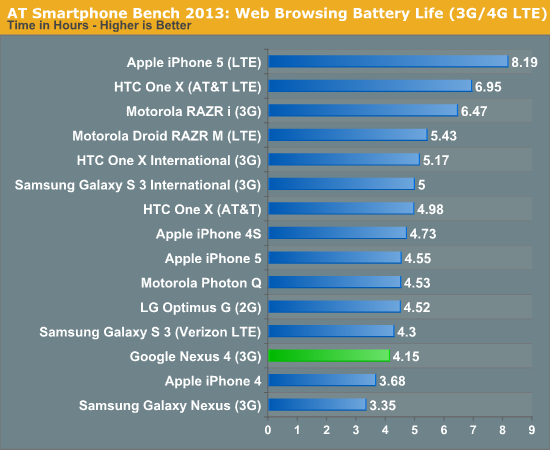
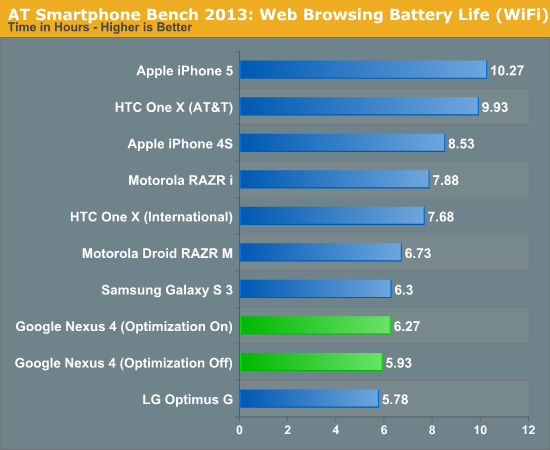
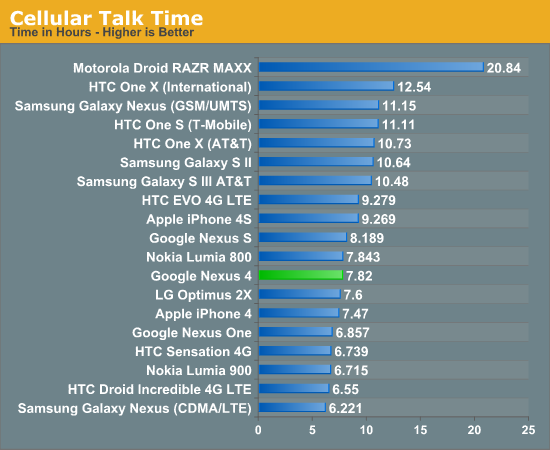
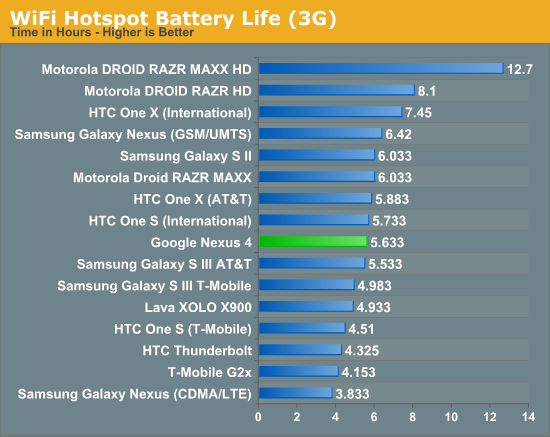
I've run and re-run the battery life tests on the Nexus 4 and they haven't changed since our preview a whole bunch. The result is battery life that isn't really chart topping, yet in my time with the Nexus 4 I haven't really been want for more battery life at any point. I'm able to get through a single day with the device set on auto brightness.



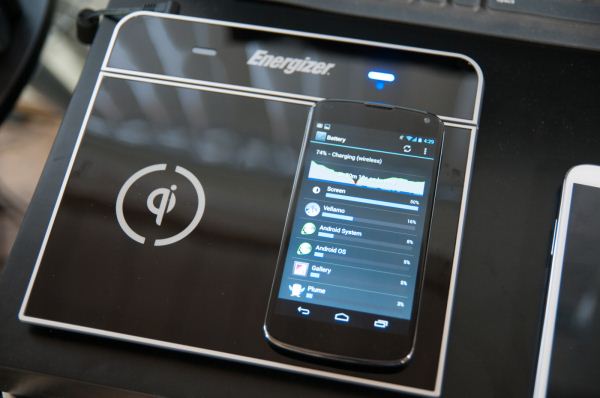

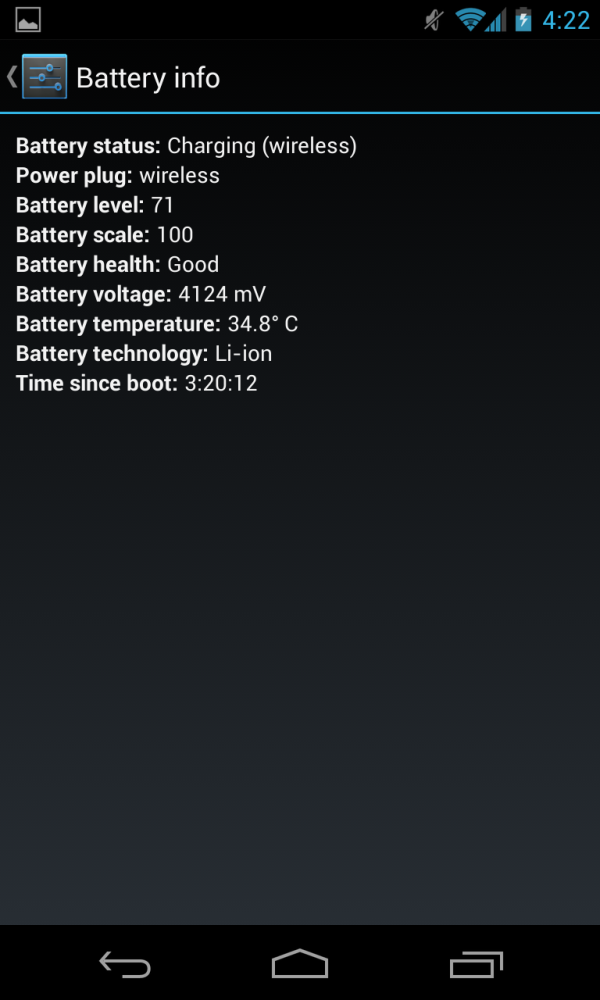








188 Comments
View All Comments
IKeelU - Tuesday, November 13, 2012 - link
I'm glad you confirmed the thermal throttling hypothesis, but it's a shame that it's happening at all. While no Google or LG exec is going to come out and tell everyone to use their phone in the cold, I see this turning into the Android version of the "your holding it wrong" meme. Perhaps Google should ship some capacitative gloves so Canadians and Scandinavians can enjoy their phones under ideal conditions ;P?Also, battery performance. It's half the iPhone 5's. Half.
Given the price and the nexus pedigree, I'm still going to buy this phone, warts and all. But the performance of the device in browsing and battery life is terribly disappointing.
amdwilliam1985 - Tuesday, November 13, 2012 - link
Again with the best test. It is not half in real life, trust me.we did real life test comparison with SGS3 and a new iphone 5, and I can see my S3 doing really well.
tuxRoller - Tuesday, November 13, 2012 - link
That suggests that the tests are not very useful.Frankly, I really like the idea of Vellamo. Testing interface performance is really useful.
The web browsing test might also be useful if it is well done (not sure if enough time is provided between page loads to actually read the page).
Perhaps use of a framework that takea actual apps and feeds them dummy data to simulate usage.
Testing is hard...
SetiroN - Tuesday, November 13, 2012 - link
The one time they could have gone with a slighly out of date SoC (the MSM8960 with its more efficient integrated baseband, or possibly the PRO) they didn't... ending up with a very power hungry platform that throttles and barely has enough battery life. Personally, I think I will disable two of the cores, but it's very appreciable that they're moving faster than before. I was really hoping for an OMAP5 (the first BIG.little A15 implementation) in the next nexus phone, obviously a few months from now, but I'll make do with the S4.It is, as usual, great how google keeps an eye on NAND performance, it really is a bottleneck in modern smartphones. Hopefully something better than 0.8MB/s random writes will be available in the near future... yes, it's 3 times faster than the competition, but still too low. We need 4/5.
I'm quite a bit against all this "high build quality" (which is apparently all about non-plastic materials) trend: not that I don't like better built phones, but plastic is FINE. It just has to be properly used, avoiding tacky chrome and glossy parts: the upside of having a lighter chassis with a removable door, and thus a repleaceble battery (which can probably be larger thanks to the spared weight) largely overcomes the improved aesthetics. Not to mention it's much less prone to serious damage as it manages to absorbs impacts well.
A glass back might be cool, but I won't notice it anymore after a week... until it breaks.
The real problems are Korean designers, not plastic materials.
In the end, higher battery life and storage space would have been much better, but at this price I won't complain, there's nothing even nearly as good. Heck, even $200 more would have been fair - and still cheaper than the competition.
Still, such a non-replaceable low lasting battery can and will be a dealbreaker to many just as much as the lack of storage. But the price is good enough to make me come to a compromise, disable 2 cores in the kernel and start carrying around a portable charger and OTG cable.
I wonder if anyone will make a nice battery cover with integrated storage :)
MTWeg12 - Tuesday, November 13, 2012 - link
Such an elaborate review. Awesome! It is nothing less than a PhD thesis.VivekGowri - Tuesday, November 13, 2012 - link
I think you seriously underestimate how long most PhD theses are. This could probably easily double as an engineering undergrad senior/final project though, as could many of our more in-depth reviews.Red Oak - Tuesday, November 13, 2012 - link
You don't point out that the iPhone 5 destroys it in your performance tests. On some, 100%+ faster. Pretty shocking, considering the Nexus has the latest four core variantThis phone is already a half step behind and has little headroom. Surprised Google would make this their flagship for the next year
amdwilliam1985 - Tuesday, November 13, 2012 - link
too bad iphone 5 is old news already, get ready for the incoming iphone 5S expected early 2013.Zink - Tuesday, November 13, 2012 - link
I think what we're all really getting ready for is the Razr Nexus 4 coming out in a year. Super thin with A15, improved battery life, 32GB and LTE.PeteH - Tuesday, November 13, 2012 - link
Maybe you are, but I won't be satisfied until I have a 64-bit ARMv8 in my phone!